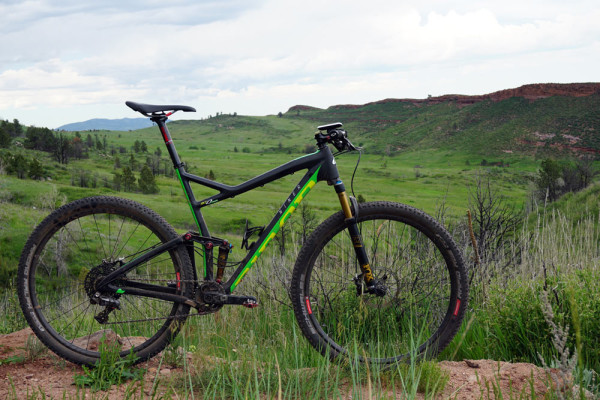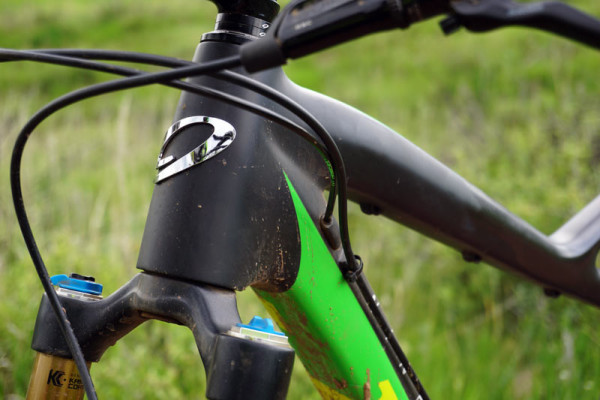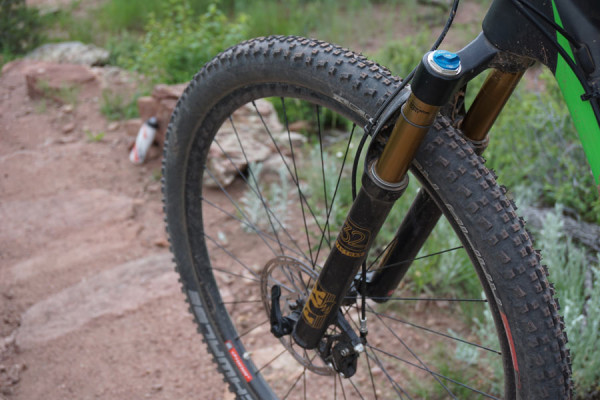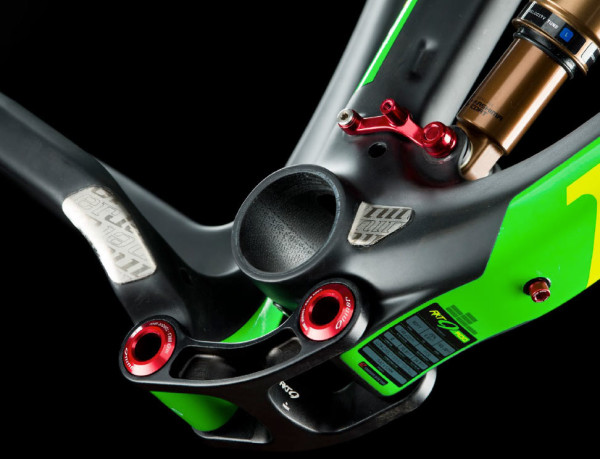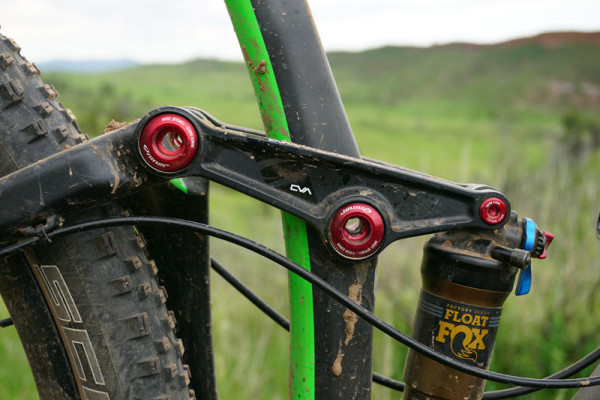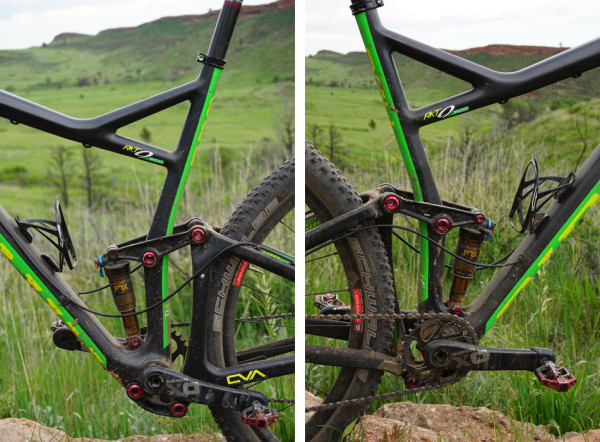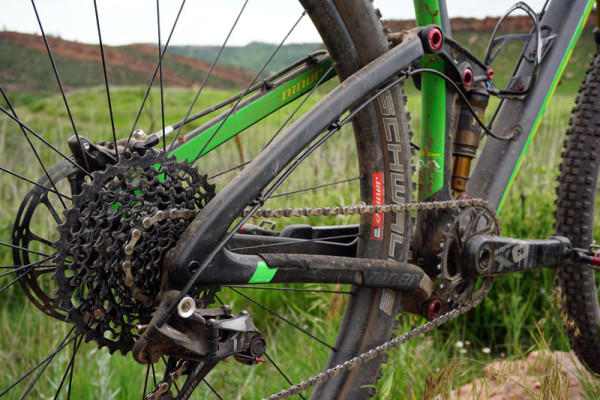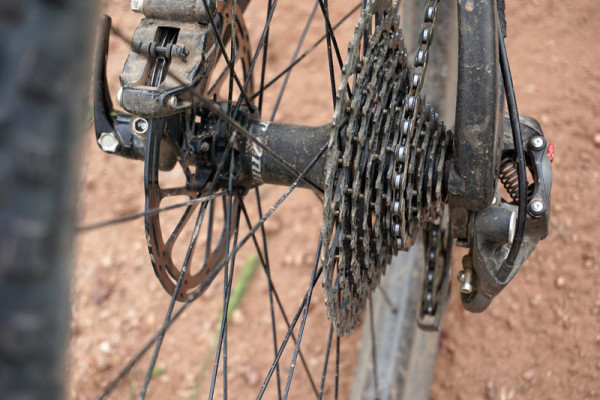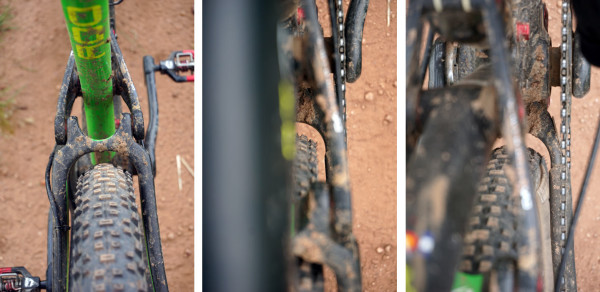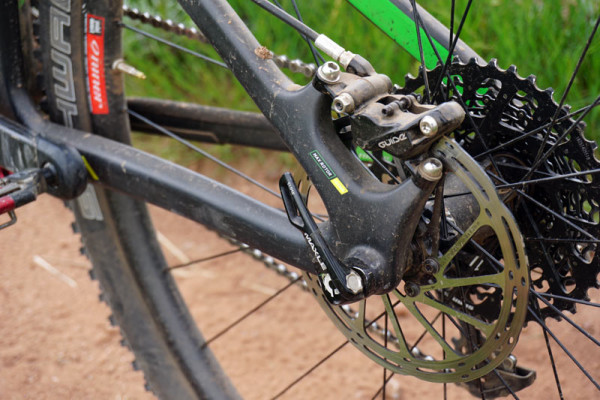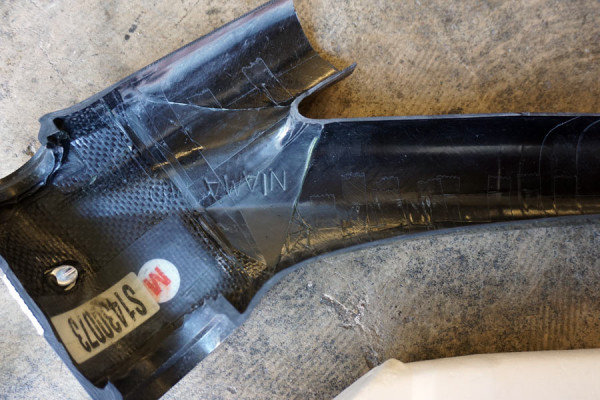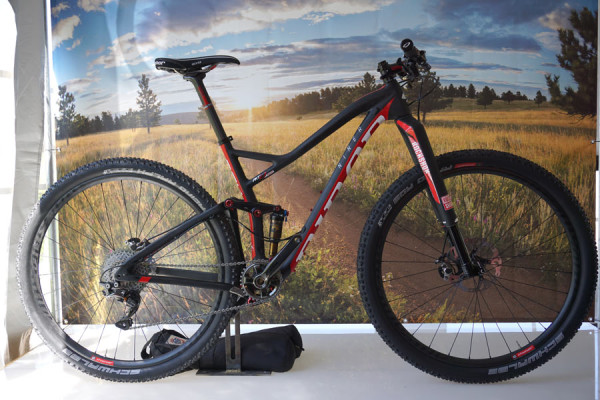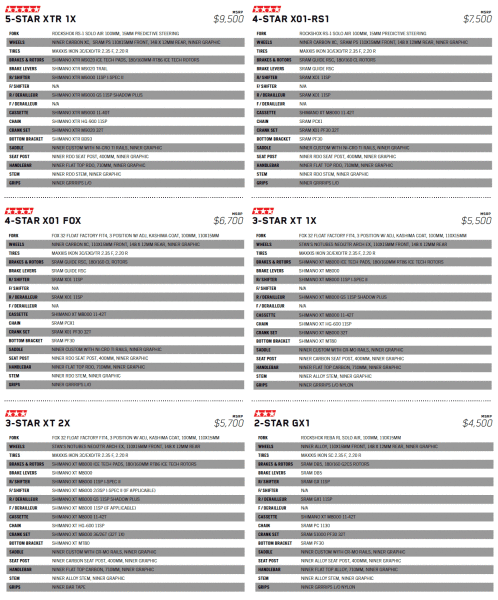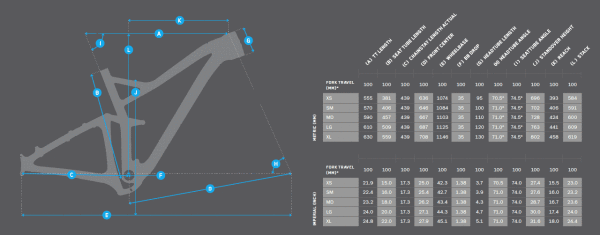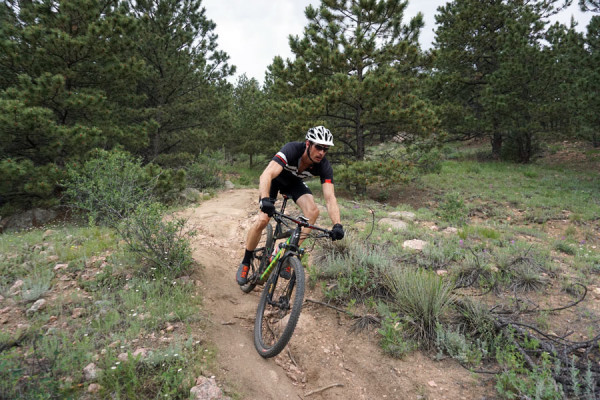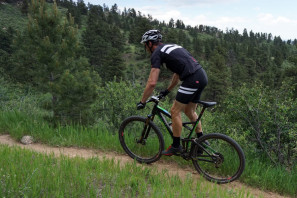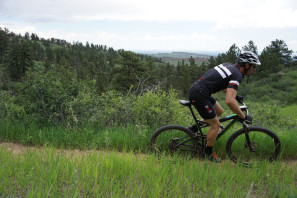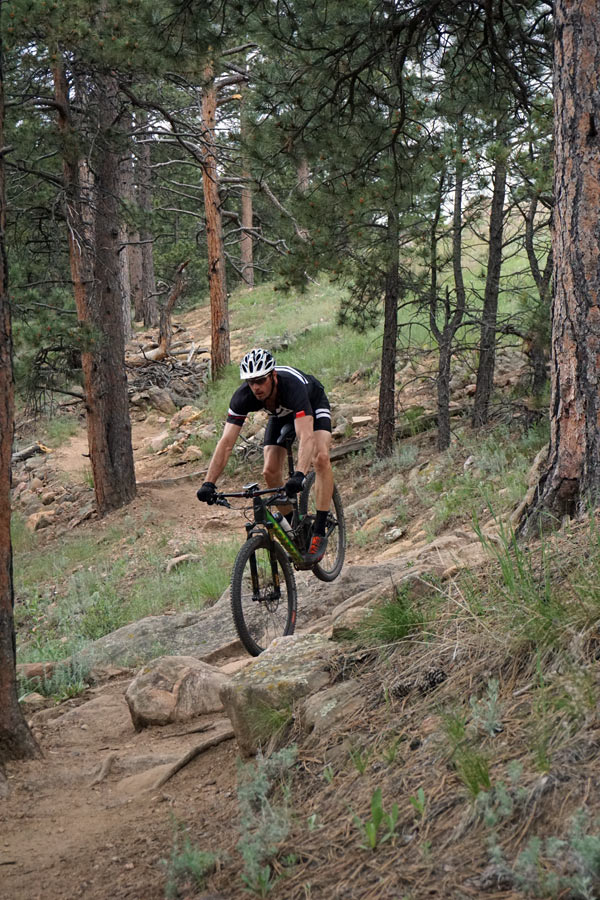This isn’t just a new bike. The Niner RKT9 is the culmination of the past five years of component, tech and rider changes. Bear with me – the development story for it does more than just explain why the RKT9 came to be.
Spec options and standards have changed rapidly over the past couple years, making it both exciting and vexing for anyone looking to upgrade their bike or major components like suspension forks or wheels.
Take suspension forks, which have trickled big fork stiffness to weights of traditionally less stiff XC forks. Think RS-1, or using a Fox 34 and Rockshox Pike with just 120mm travel. Out back, the new Fox DPS shocks have added actual, discernible change to its compression damping.
And 1x drivetrains have simply taken over thanks to wide range cassettes, clutch rear derailleurs and narrow/wide chainrings making them work exceptionally well for a wide range of conditions and riders. It’s also let frame builders to do things they simply couldn’t do with double or triple chainrings.
Even more than 1x drivetrains, Boost 148 opens up a lot of options on the frame, letting designers use shorter chainstays and bigger tire clearance. It also means drastically stiffer wheels, making 29er wheel deflection equal to a 26” wheel.
Put it all together and you get something that represents the future of Niner’s mountain bikes…
Niner is always quick to adopt new technologies and parts thanks to their build-on-demand warehouse system. But they’re also quick to adopt technologies that’ll make their bikes better…like all the things mentioned above. But to say they’re excited about Boost 148 is an understatement.
The development cycle isn’t just dictated by what new tech and spec is available. Those are helpful for making the existing bikes better, but what if an existing bike doesn’t serve the needs of customers? Then you look at the way your customers are using your bikes and pay attention to the fringes. The ROS9 came about after they saw EMD9 frames being built with Angleset headsets and huge tires. And freeride and enduro led to the WFO9.
Fast forward to today and they’re seeing the JET9 being turned into more of a light trail bike, with riders putting 120mm forks and wider bars and tires on it. As that became more common, they thought there might just be room for a more pure bred race machine. A real race rocket for XC and marathon, and so the RKT9 was born.
The short of it: Race geometry with a 100mm fork and 90mm of CVA suspension in the rear, which splits the difference between the original 80mm alloy JET9 and the current 100mm design. And Boost 148 rear spacing.
The RKT9 has modern race geometry that lets you get lower on the front end of the bike. Headtube is 10mm shorter than the JET9, and standover height is the lowest of any of their bikes.
They liked the way the JET9 handled with a 120mm fork, which put the head angle at 70.5º, so they came close to that at 71º with a 100mm fork on the RKT9. (note: head angle has been updated/corrected since post first went live – info here is accurate.)
The cable ports on the headtube use their new style that insert behind the steerer rather than through the head badge, which makes setup much easier. Shift cable routing runs internally through the downtube, with a double-sized port on the driveside to work with both rear derailleur and Sideswing front Shimano derailleurs.
The front derailleur mount replaces the lower shock nut by incorporating a thread capture for the shock bolt while holding a low direct mount FD. Remove it and put the anodized color-matched nut back in place and you’d never know it could fit a front derailleur. Between the two is the Di2 wire port, making the frame compatible with any modern drivetrain.
Even though it’s designed as an XC/marathon race bike, there’s routing for a stealth or standard dropper post, too, and complete bikes will come with a remote lockout Fox shock. Titanium plates and clear laminate sheets protect high impact areas from rock strikes and chain drops.
The shock’s eye-to-eye distance is shorter, so it uses a smaller, lighter shock. And the upper rocker arms are 6066 alloy, which they say ended up being lighter and stiffer than the carbon ones the new alloy linkages – 81g with bearing compared to 100g for the carbon linkages with bearing. That’s 19g savings, or simple math, 19% lighter! And they’re easier to produce.
Linkages pivot on Enduro Black Oxide bearings like all of their RDO models.
Chainstays are 439mm (17.28”), compared to 455mm (17.91″) on the JET 9.
The Boost 148 rear end is fitted with either Niner or Stan’s rear hubs and the latest (more durable!) Maxle.
Besides the stiffer wheels and shorter chainstays a Boost system allows for, it also makes room for up to 2.4″ tires. These pics show clearance with a 29×2.25. On the other side of the stays, it’ll clear a 1x crankset with up to a 38-tooth chainring or a standard double or triple crankset.
Post mount brakes for 160-180mm rotors in the rear.
The frame is claimed at 4.5lb (2.04kg) with shock, size medium. That’s half a pound lighter than the JET9 RDO. Besides being a slightly smaller frame and the new rocker arms, weight savings come from using their new RDO carbon compaction method…
…which uses a hard EPS mold through the main tubes and firm flexible joint piece. Having a hard inner mold, as opposed to an inflatable bladder, lets them apply higher pressure to squeeze out more excess resin. After molding and curing, the foam is melted and broken up, then pulled out. The joint molds are then pulled out, too, leaving a smooth inner surface.
Actual weight for the XTR bike is 23.3lb (10.57kg) and the X01 is 23.24lb (10.54kg), both with RS-1 forks.
Color options are Black/Red and Green/Greener. Prices and builds are (click to enlarge):
It’s likely an XTR Di2 build will be offered as a limited edition model at some point.
Click image to enlarge.
FIRST RIDE REVIEW
Niner invited us to ride the new RKT9 at their dealer event this summer, taking to the trails around their Fort Collins, CO, headquarters. There were plenty of long and steep climbing, fast and technical descents and flowing singletrack cutting across the mountain sides.
During the presentations, they hammered home the point that they wanted the lateral stiffness of this bike to be very high. The Boost designs and wheels help, as do oversized pivot bearings throughout the linkages. On the trail, it was obvious the plans worked, but since it’s a completely new model, there’s no way of telling how much comes from the Boost wheels and how much is the frame. My test bike had the 2016 Fox 32 FIT4 Boost fork, which I reviewed here. The point is, as a system, it works incredibly well.
I’d be lying if I said I wished it hadn’t. That Boost was just a bunch of marketing hype, but this bike proves it’s not. There are simply too many benefits to ignore, and they all come to fruition here.
Short chainstays and ultra stiff wheels meant I could throw the bike through complicated drops strewn with rocks, off-angle ledges and tight corners with ease. And high speed cornering and sweeping turns were impressively easy to control. It’s like the difference between riding lightweight alloy wheels and lightweight carbon wheels…there’s a drastic difference in stiffness, and it’s immediately apparent.
Climbing, whether seated and spinning, standing and sprinting, or delicately picking through precarious rock-and-root sections with certain death off to the right were all handled without drama. Again I credit the overall stiffness and short chainstays. There’s no guessing what the bike will do, it simply moves where you tell it to, and power transfer is quick and efficient. I’ve been a fan of Niner’s CVA suspension since my first ride, and it’s as good as ever here, keeping the rear wheel on the ground even when sprinting over ruts, roots and rocks without bobbing outta control on every pedal stroke.
Where the bike may surprise some is with its downhill prowess. We rode through fast rolling descents that switchbacked down a mountainside and over a few steep rocky sections that’d be perfectly at home on a DH course. On both, the short travel kept up. Which is good, because XC courses are becoming more technical, and this bike seems up to the task. Even with the low front end and slightly shorter (by 5mm) top tube than what I’m used to on my JET9, I never felt like I was in danger of going over the bars. It’s no trail bike, but it’ll rip through a World Cup XC course.
Are there downsides? Hard to say from just one half-day ride. My experience was good, and the dealers on the ride all seemed impressed. Beyond XC, there’s a big market for marathon full suspension bikes throughout the world, and the RKT9 hits that segment’s sweet spot for weight, travel and the fact that it’ll hold two water bottle cages on all but the XS and S sizes. If you wanna ride your own, they’re available starting October 1, and Niner will have demos at Outerbike in Moab. As for me, I’m very much looking forward to getting a long term test bike in this fall…
